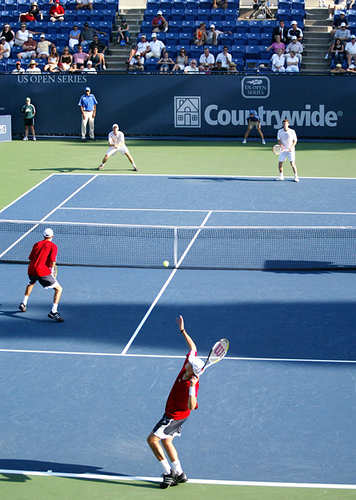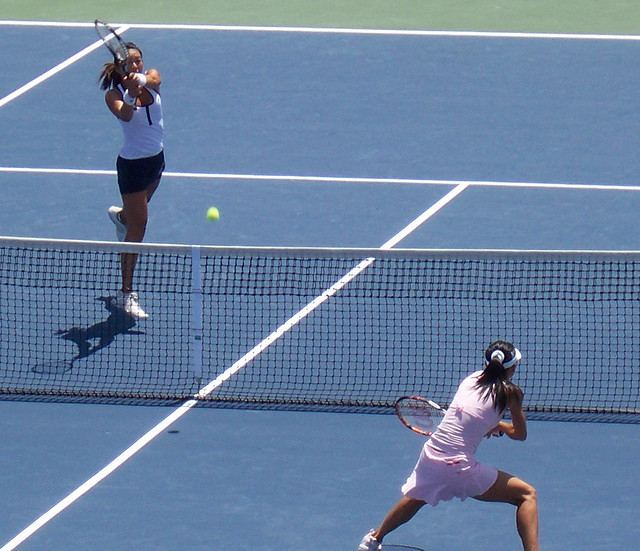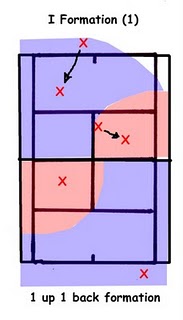A wise and well thought out series of doubles tennis tactics must be executed if a team wishes to progress to a higher level of play. Combined with the appropriate doubles tennis tactics and strategy, a team should also consider forming an organized plan of attack to beat their opponents.
Tennis doubles tactics begin the moment a team steps on the tennis court. Every movement and shot choice must be carefully placed to defeat an experienced team of doubles experts. Before we dive into the nitty gritty of doubles tennis tactics, we must first explore the basics of the game.
Basics of Tennis Doubles Tactics
Tennis doubles is one example of a team sport that is fun and interesting to play. Tennis singles is considered a battle of wits between two competing players, whereas the tennis doubles focus more on the teamwork and partnership aspects of the game. In a competitive point of view, it is very important to know and execute the specific tennis doubles tactics and strategies to win matches.
Serve and Volley Tennis Doubles Tactics


In professional tennis, the serve and volley is a common practice utilized after the first serve or even after the second serve. However, with the advent of very powerful groundstokes in modern tennis, doing a serve and volley attack is getting more difficult.
As a result, groundstroke returns is more common than the serve and volley. However in professional tennis, the serve and volley still remains as one of the most effective tennis doubles tactics. The reason for this is the fact that the server or the server’s partner can always execute a low or an excellently placed return that lead to a weak or faulty return from the receiver’s team.
For the players to execute an exceptional serve and volley return, they need to have more than just the skills but a lot of practice as well. During their practice they need to achieve a higher percentage of good hits than the miss hits.
On the receiver’s team point of view, if the receiver’s partner anticipates an aggressive volley return, he or she should be ready to move backwards until the opponents are about to hit the ball. But if he or she anticipates a powerful groundstroke, he or she should move forward to pick off his teammate’s weak return.
Poach in Tennis Doubles Tactics


If the serving team plans a poach, the server’s partner does a hand signal that he/she is going to poach regardless of the receiver’s return (weak or powerful). Just as the receiver starts to swing the racket, the server’s partner immediately cut diagonally forward and towards the side of the server.
The poach will be very effective and most probably will give a point to the server’s team if the receiver hits the usual cross-court return. The server on one hand has to cover the space vacated by his partner to avoid an open court. An open court will give their opponents an opportunity to hit a winner shot.
Hand signals are normally used by each team member in this type of execution. The signals are one finger to poach after the first serve; two fingers to poach after the first or the second serve and no finger for no poach.
The hand signal should be done at the start of a point and the server should reply by saying yes or no if he/she understood the sign or not. Signals and communication may vary between teams. Sometimes, it’s the server who tells his/her partner when to poach and where he/she will hit the serve. In cases like this, the players normally confer before the start of a point.
Using Doubles Tennis Tactics With the I Formation


The I formation is one of the most common serving doubles tennis tactics. The server executes the serve near the center point of the baseline. The server’s partner positions at the midpoint point of the center service line and crouches.
The crouching posture limits the destruction for the server’s point of view since he/she is just behind his/her partner. Immediately after the ball passes over the server’s partner, he/she anticipates the return and cut diagonally towards the ball. In the same manner as the Poach tactic, the server’s partner has to give a hand signal to the server so that the server can cover the open court.
After the serve, the server has to stand on the middle part of the court for him/her to quickly run towards the open court. In addition, the server has to be ready at any time for a possible straight down return in the middle of the court if his/her partner misses to reach the ball.
This I formation tactic is very effective in confusing the receiver’s team and to get them out of their momentum if there are very good in returning serve.


Australian Formation: An advanced doubles tennis tactic


The Australian formation is where both players (the server and the server’s partner) stand on the same side of the court. Like for instance, if the server serves in the deuce court (beside the center part of the baseline), the server’s partner stands on the service box in front of the server and positioned close to the center service line and to the net.


The Australian formation is one of the examples of tennis doubles tactics that is very effective in destroying the opponents’ effective return of serve. Cross-court shot is normally used to return a serve in tennis doubles matches and the Australian formation puts the opponents out of their comfort zone by forcing them to return a forehand or a backhand down the line shot.
Specific Tennis Doubles Tactics
Tennis Doubles Tactics #1: Fake Poach
From the name itself, the server’s partner pretends to poach by moving early (earlier than when you actually do poach) for the opponents to see him/her moving but only to move back to cover the doubles alley. The server’s partner should move always confusions to the opponents as to what the next returns will be.
Tennis Doubles Tactics #2: The server
In tennis doubles, the server normally stands between the doubles sideline and the center. One of the tennis doubles tactics is to keep the receiver guessing on the type of serve to hit by changing the serving positions every now and then. Like for example if you are planning to hit the backhand side of the receiver, try to be deceptive and stand at a point where the receiver won’t anticipate your serve.
Tennis Doubles Tactics #3: Cringe
In tennis doubles especially for the less experience players, it is very easy to be hit by your opponent’s ball. If your opponent intends to hit any part of your body or your racket to put you off balance, try to evade it as much as possible because you partner has still a chance keep the ball in play.
Tennis Doubles Tactics #4: One-up or one-back
This tennis doubles tactic means that one player is positioned near the net while the other player is positioned further back. This tactic is less effective compared to the two-up (means the two players stand near the net) but it can still be effective in some circumstances. This can be useful when your opponents do not like to play net or when they like to lob.


Tennis Doubles Tactics #5: Angled volley
Angled volley shots are volley shots hit to the side of the court instead of hitting the ball straight in front of you. It is ideal to hit angled volley shots when both or one of the opponents are positioned at the back.
Tennis Doubles Tactics #6: Get the first serve in
It is more difficult to return a serve (especially the first serve) in tennis doubles than in tennis singles because of the server’s partner who normally stands at the net. Thus, for the server’s team side, one of the best tennis doubles tactics to win points is to let the first serve in. The server’s team has a better chance of winning if they achieved high percentage of good first serve.
Tennis Doubles Tactics #7: Proper communication
One of the tennis doubles tactics that may make or break a tennis doubles match is the team’s communication. Team work is lost in the absence of communication and the absence of team work in tennis doubles means disaster. Proper communication is vital for the two players in a team to play as one. Right and timely communication allows the players to execute the perfect and timely tennis doubles tactics to win points.
Tennis Doubles Tactics #8: Good movement coordination
Since tennis doubles is a teamwork game, movement coordination between the two players is vital. In tennis doubles, it is necessary not to leave an open court or else your opponents find an opportunity for an offensive attack. Thus, one member of the team should try to cover an open court left by the other player. Like for example, if the server’s partner has to run to the far right side to return a wide shot, the server should move in the same direction to avoid an open court.
Learn to Hit a Forehand Like Roger Federer
If you want to jumpstart your forehand and play like the PROS, check out my 70+ page Tennis Ebook that will immediately show you how you can take your forehand to the next level.
The Modern Forehand Domination Ebook is guaranteed to improve your tennis technique, and increase power, topspin and accuracy of your tennis forehand!
Modern Tennis Forehand Ebook
Learn How to Hit a Forehand Like Federer, Nadal and Djokovic

